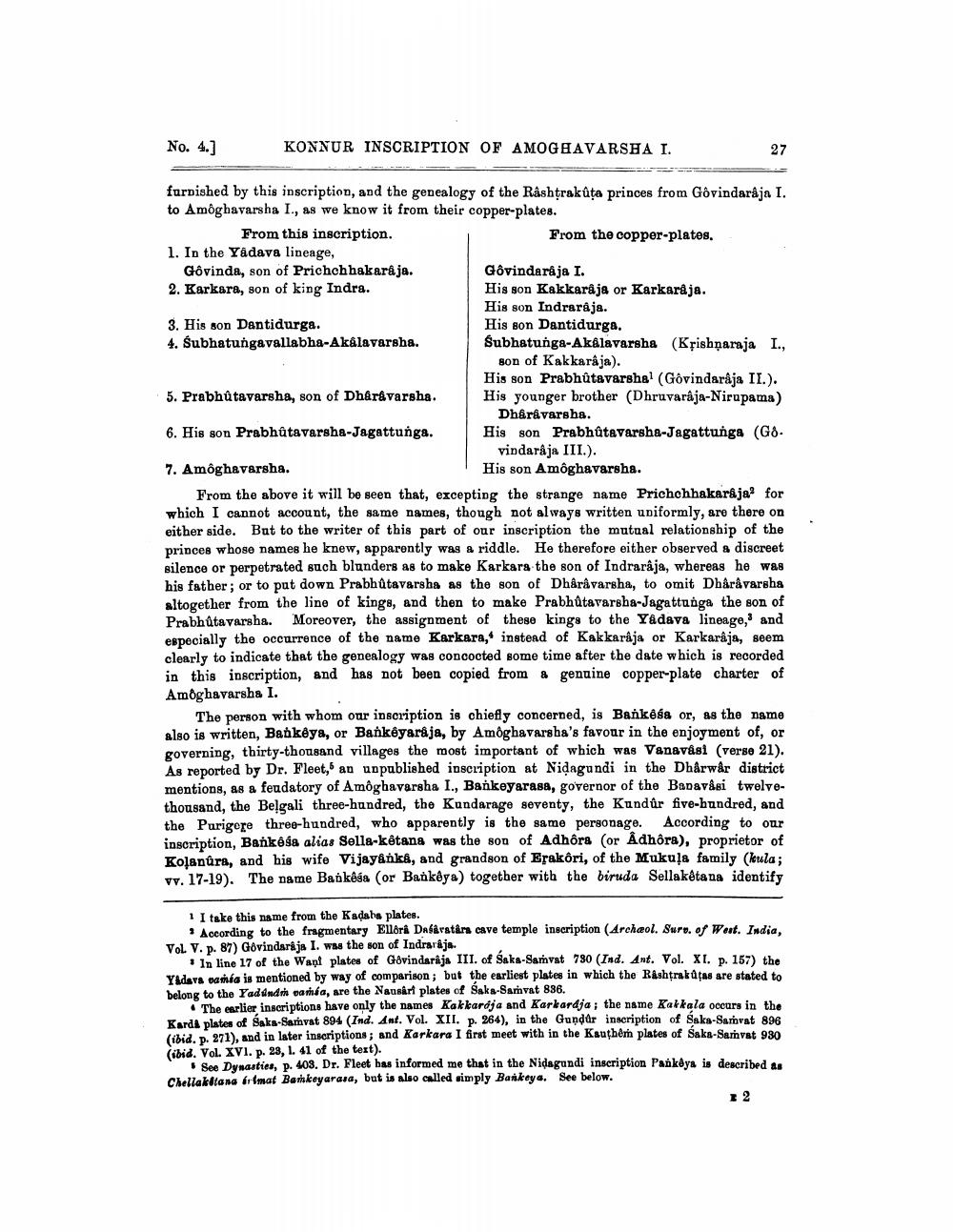________________
No. 4.]
KONNUR INSCRIPTION OF AMOGHAVARSHA I.
furnished by this inscription, and the genealogy of the Rashtrakůta princes from Govindaraja I. to Amoghavarsha I., as we know it from their copper-plates, From this inscription.
From the copper-plates. 1. In the Yadava lineage, Govinda, son of Prichchhakarája.
Gôvindaraja I. 2. Karkara, son of king Indra.
His son Kakkaraja or Karkarå ja.
His son Indraraja. 3. His son Dantidurga.
His son Dantidurga 4. Subhatungavallabha-Akalavarsha. Subhatunga-AkÁlavarsha (Krishnaraja I.,
son of Kakkarája).
His son Prabhůtavarshal (Govindaraja II.). 5. Prabhůtavarsha, son of Dhåravarsha. His younger brother (Dhruvarâja-Nirupama)
Dhårkvarsha. 6. His son Prabhutavarsha-Jagattunge. His son Prabhůtavarsha-Jagattunga (G8.
vindaraja III.). 7. Amôghavarsha.
His son Amoghavarsha. From the above it will be seen that, excepting the strange name Prichchhakarája? for which I cannot account, the same names, though not always written uniformly, are there on either side. But to the writer of this part of our inscription the mutual relationship of the princes whose names he knew, apparently was a riddle. He therefore either observed a discreet silence or perpetrated such blanders as to make Karkara the son of Indrarâja, whereas he was his father; or to put down Prabhutavarsha as the son of Dhåråvarsha, to omit Dháråvarsha altogether from the line of kings, and then to make Prabhůtavarsha-Jagattunga the son of Prabhůtavarsha. Moreover, the assignment of these kings to the Yadava lineage, and especially the occurrence of the name Karkara, instead of Kakkarija or Karkaraja, seem clearly to indicate that the genealogy was concocted some time after the date which is recorded in this inscription, and has not been copied from a genuine copper-plate charter of Amoghavarsha I.
The person with whom our inscription is chiefly concerned, is Bankega or, as the name also is written, Bankêya, or Bankêyaraja, by Amoghavarsha's favour in the enjoyment of, or governing, thirty-thousand villages the most important of which was Vanavasi (verse 21). As reported by Dr. Fleet, an unpublished inscription at Nidagundi in the Dharwår district mentions, as a feudatory of Amôghavarsha I., Bankeyarasa, governor of the Banavasi twelvethousand, the Belgali three-hundred, the Kundarage seventy, the Kundûr five-hundred, and the Purigere three-hundred, who apparently is the same personage. According to our inscription, Bankega alias Sella-kêtana was the son of Adhôra (or Adhôra), proprietor of Kolanûra, and his wife Vijayanka, and grandson of Erakori, of the Mukuļa family (kula; vv. 17-19). The name Bankêsa (or Bankêya) together with the biruda Sellaketana identify
1 I take this name from the Kadahs plates.
* According to the fragmentary Ellora Dafêratårs cave temple inscription (Archæol. Suro. of Wout. India, Vol V. p. 87) Govindaraja I. was the son of Indraraja.
In line 17 of the Waņi plates of Govindaraja III. of Saka-Samvat 780 (Ind. Ant. Vol. XI. p. 157) the Yuva vanhia is mentioned by way of comparison; but the earliest plates in which the Rashtraktas are stated to belong to the Yadindth paria, are the Naukri plates of Saks-Sarhvat 886.
The earlier inscriptions have only the names Kakkarája and Karkardja; the name Kakkala occurs in the Karda platen of Saks-Samvat 894 (Ind. Ant. Vol. XII. p. 264), in the Gundar inscription of Saka-Sarvat 896 (ibid. p. 271), and in later inscriptions; and Karkara I first meet with in the Kauthêm plates of Saka-Sarvat 930 (ibid. Vol. XVI. p. 23, 1. 41 of the text).
See Dynasties, p. 403. Dr. Fleet has informed me that in the Nidagundi inscription Pankoya is described as Chellakltana frimat Barkeyarasa, but is also called simply Barkeya. See below.




